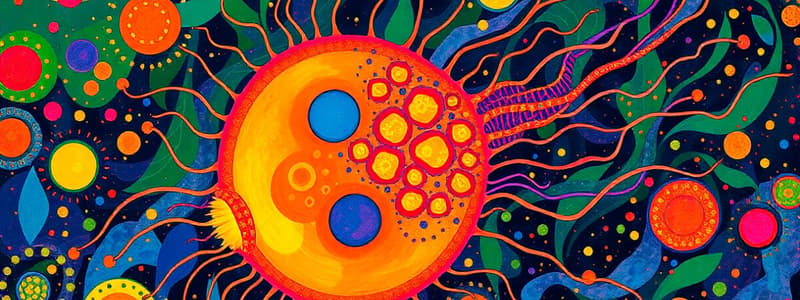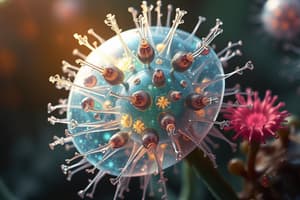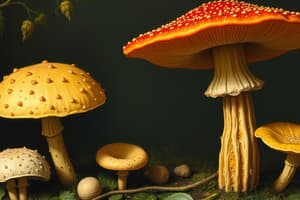Podcast
Questions and Answers
Which characteristic is common to all protists?
Which characteristic is common to all protists?
- Prokaryotic cell structure
- Multicellular organization
- Eukaryotic cell structure (correct)
- Autotrophic nutrition
How does Plasmodium infect its host?
How does Plasmodium infect its host?
- Through direct contact with infected water
- Via airborne spores that are inhaled
- Through the bite of an infected female _Anopheles_ mosquito (correct)
- By penetrating the skin directly
What is the primary function of the eyespot (stigma) in Euglena?
What is the primary function of the eyespot (stigma) in Euglena?
- Maintaining osmotic balance
- Sensing changes in water temperature
- Detecting prey organisms
- Detecting the intensity and direction of light (correct)
Which of the following locomotion methods is associated with Paramecium?
Which of the following locomotion methods is associated with Paramecium?
What key feature distinguishes Trypanosoma from Euglena?
What key feature distinguishes Trypanosoma from Euglena?
Which structure is used by Amoeba for movement?
Which structure is used by Amoeba for movement?
What is the primary function of flame cells in flatworms?
What is the primary function of flame cells in flatworms?
What characteristic of tapeworms allows them to survive without a digestive system?
What characteristic of tapeworms allows them to survive without a digestive system?
What is the adaptive significance of the location of the pharynx in planarians?
What is the adaptive significance of the location of the pharynx in planarians?
Which term describes an organism that possesses both male and female reproductive organs?
Which term describes an organism that possesses both male and female reproductive organs?
What is the term for an animal lacking a body cavity where their internal organs are embedded in solid tissue?
What is the term for an animal lacking a body cavity where their internal organs are embedded in solid tissue?
What adaptation do flukes possess to protect themselves from host enzymes?
What adaptation do flukes possess to protect themselves from host enzymes?
Which feature is NOT a characteristic of mollusks?
Which feature is NOT a characteristic of mollusks?
What is the function of the mantle in mollusks?
What is the function of the mantle in mollusks?
How do bivalves obtain food?
How do bivalves obtain food?
What specialized adaptation allows cephalopods to be active predators?
What specialized adaptation allows cephalopods to be active predators?
How do adductor muscles contribute to the survival of clams?
How do adductor muscles contribute to the survival of clams?
What is the primary function of the radula in most mollusks?
What is the primary function of the radula in most mollusks?
Which class of mollusks includes snails?
Which class of mollusks includes snails?
What is the function of pseudopodia in amoebas?
What is the function of pseudopodia in amoebas?
Flashcards
Characteristics of Protists
Characteristics of Protists
Unicellular, eukaryotic organisms with diverse nutrition modes.
Flagella
Flagella
Whip-like tail for movement (e.g., Euglena).
Cilia
Cilia
Short, hair-like structures beating in unison (e.g., Paramecium).
Pseudopodia
Pseudopodia
Signup and view all the flashcards
Eyespot (stigma) in Euglena
Eyespot (stigma) in Euglena
Signup and view all the flashcards
Plasmodium Infection
Plasmodium Infection
Signup and view all the flashcards
Plant-like Feature of Euglena
Plant-like Feature of Euglena
Signup and view all the flashcards
Animal-like Feature of Euglena
Animal-like Feature of Euglena
Signup and view all the flashcards
Body Plan of Flatworms
Body Plan of Flatworms
Signup and view all the flashcards
Monoecious
Monoecious
Signup and view all the flashcards
Acoelomate
Acoelomate
Signup and view all the flashcards
Mollusk Characteristics
Mollusk Characteristics
Signup and view all the flashcards
Adaptive Radiation (Mollusks)
Adaptive Radiation (Mollusks)
Signup and view all the flashcards
Snail Locomotion
Snail Locomotion
Signup and view all the flashcards
Bivalves
Bivalves
Signup and view all the flashcards
Cephalopods
Cephalopods
Signup and view all the flashcards
Adductor Muscles in Clams
Adductor Muscles in Clams
Signup and view all the flashcards
Study Notes
Animal-Like Protists (Lab 4)
-
Key groups include Euglenozoa, Kinetoplastids, Apicomplexa, Ciliophora, and Unikonta.
-
Protists are characterized as unicellular, eukaryotic organisms that are mostly aquatic.
-
Protists nutrition include diverse modes, such as autotrophic and heterotrophic.
Modes of Locomotion
-
Flagella: used by Euglena
-
Cilia: used by Paramecium and Vorticella
-
Pseudopodia: used by Amoeba
-
Euglena possess a flagellum (whiplash type) and a red eyespot (stigma) for detecting light
-
Trypanosoma are parasitic, lack chloroplasts and absorb nutrients from a host's blood
-
Plasmodium lacks locomotion organelles, infects red blood cells, and causes malaria
-
Paramecium use cilia for movement and feeding and have an oral groove, contractile vacuole, micronucleus, and macronucleus
-
Vorticella are sessile and use cilia around the peristome for generating feeding currents.
-
Amoeba move using pseudopodia and lack a rigid cell wall.
Eyespot Function in Euglena
- Detects light, enabling movement towards light sources for photosynthesis (positive phototaxis).
Protist Locomotion Methods
- Flagella: Whip-like tail for movement. (e.g., Euglena)
- Cilia: Short, hair-like structures beating in unison. (e.g., Paramecium)
- Pseudopodia: Extensions of cytoplasm for crawling. (e.g., Amoeba)
Plasmodium Infection
- Transmitted by the bite of an infected female Anopheles mosquito.
- Enters the bloodstream and infects red blood cells.
Euglena Features
- Plant-like: Contains chloroplasts for photosynthesis.
- Animal-like: Moves using a flagellum and feeds heterotrophically without light.
Microscope Identification
- Identify Euglena (flagellum, eyespot)
- Find Trypanosoma among blood cells
- Find Plasmodium inside red blood cells
- Recognize Paramecium structures (oral groove, macronucleus)
- Find Amoeba pseudopodia
- Find Vorticella stalk and cilia
Flatworms (Platyhelminthes) - Lab 7
-
Classes include Turbellaria, Trematoda, and Cestoda.
-
Flatworms Body plan: Acoelomate, triploblastic, with bilateral symmetry.
-
Planaria (Turbellaria): Free-living with eyespots (light detection) and auricles (chemoreception)
-
Flukes (Trematoda): Parasitic with oral/ventral suckers and an extensive reproductive system.
-
Tapeworms (Cestoda): Parasitic without a mouth or digestive system; the body is made of proglottids.
-
Flame Cells: Excretory structures for osmoregulation.
Planaria's Pharynx
- Centrally located to allow feeding while remaining flat.
- Enables feeding from any direction and supports the body plan.
Monoecious and Acoelomate
- Monoecious: Organism with both male and female reproductive organs (hermaphroditic).
- Acoelomate: Lacks a body cavity; internal organs are embedded in solid tissue (e.g., flatworms).
Fluke Protection
- Tough outer tegument (cuticle) resists digestive enzymes.
- Protects from the host's immune system.
Tapeworm Digestion
- Tapeworms absorb pre-digested nutrients directly from the host's intestines through their body surface
- This makes a digestive system unnecessary.
Microscope Identification
- Identify Planaria w.m. and c.s. (auricles, pharynx, eyespots)
- Find Fasciola / Clonorchis (oral sucker, ventral sucker)
- Find Taenia proglottids (scolex, hooks, suckers, reproductive organs)
Molluscs (Lab 8)
- Classes include Gastropoda (Snails), Bivalvia (Clams), and Cephalopoda (Squid).
Mollusk Characteristics
- Soft body, muscular foot, mantle, radula (except bivalves) with bilateral symmetry.
- Adaptive Radiation: Variety of body forms adapted to different environments.
- Snail Locomotion: Uses a muscular foot and secretes mucus.
- Bivalves: Filter feeders, sedentary, with an open circulatory system.
- Cephalopods: Active predators with a closed circulatory system and highly developed eyes.
Mollusk Features
- Muscular foot
- Visceral mass
- Mantle
- Radula (except in bivalves)
Foot Structure Comparison
- Snail (Gastropod): Broad, muscular foot for crawling.
- Clam (Bivalve): Wedge-shaped foot for digging/burrowing.
- Squid (Cephalopod): Modified foot forms tentacles and arms for grasping prey and movement.
Cephalopod Sensory Systems
- Cephalopods, being active predators, use rely on advanced eyes, large brains, and sensory tentacles.
- These help them locate prey and avoid predators.
Clam Adductor Muscles
- Hold clam shells tightly closed
- Provide protection from predators and prevent desiccation.
Specimen Identification
- Identify external and internal features of a snail (tentacles, eyes, foot)
- Locate Clam's adductor muscle, gills, visceral mass, and heart.
- Identify Squid's tentacles, siphon, mantle, ink sac, and gills.
Comprehensive Questions
- Match organisms to phylum/class
- Identify structures with a microscope or specimen tray
- Compare Planaria vs. Tapeworms
- Compare Euglena vs. Paramecium
- Compare Bivalves vs Cephalopods
- Explanation of how Paramecium feeds
- Explanation of the life cycle of Plasmodium or Fasciola
- Describe how flatworms excrete waste
- Describe how planaria can learn
- Discuss adaptive radiation in mollusks
- Explain the importance of the protist group related to sponge ancestors
Practical Exam Tips
- Master microscope focusing techniques
- Familiarize yourself with slides and preserved specimens
- Practice labeling diagrams of protists, flatworms, and mollusks
- Understand the functions of each structure, not just names
Studying That Suits You
Use AI to generate personalized quizzes and flashcards to suit your learning preferences.




